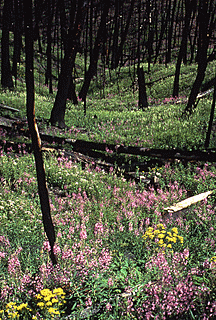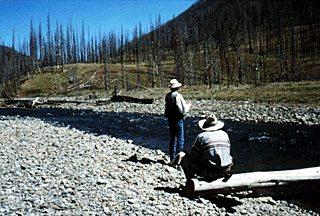 Our decent from Frost Lake was no less
exciting. After traversing rocky trails along a series of ridges, we plunged
down nearly 4,000 feet in a little over two hours through another series of
switchbacks, these as steep and dangerous as those going up from the Lamar
Valley. My thighs burned from the strain of riding at a 45-degree angle for
hours on end. The forest, although mostly burned out and covered in flowers
seemed pleasant as the sound of rushing water accompanied us all the way
down through another 20-30 switchbacks to the North Fork of the Shoshone
River. Here, downed trees littered the landscape on a grassy hillside above
the rushing, rock-strewn river. Our decent from Frost Lake was no less
exciting. After traversing rocky trails along a series of ridges, we plunged
down nearly 4,000 feet in a little over two hours through another series of
switchbacks, these as steep and dangerous as those going up from the Lamar
Valley. My thighs burned from the strain of riding at a 45-degree angle for
hours on end. The forest, although mostly burned out and covered in flowers
seemed pleasant as the sound of rushing water accompanied us all the way
down through another 20-30 switchbacks to the North Fork of the Shoshone
River. Here, downed trees littered the landscape on a grassy hillside above
the rushing, rock-strewn river.
Rocks littered the trail. By this time, we felt the heat of the sun, as
the high-mountain winds subsided. We plodded along the riverside trail until
we got to an abandoned hunting camp. At the centerpiece of this camp stood a
high platform made of logs with a hole in its floor through which a ladder
protruded. This, Alex told us, was to hold the camp provisions, keeping them
out of the reach of bears. It looked more like a Native American funeral
pyre. Corals had been dismantled, and the camp seemed overgrown, like it
hadn’t been used in years.
During our time on the trail, we saw few animals, an unusual circumstance
in Yellowstone Park. Contrary to media reports and speculation at the time,
the fires killed very few park animals. Rangers estimated that about 345
elk, 36 mule deer, 12 moose, 6 black bears, and 9 bison had perished. And
only one of the 21-known grizzlies perished. Of all the forest animals,
squirrels, chipmunks, and other rodents had the highest mortality rates due
to the heat and smoke, but also because of the reduced forest cover,
allowing their predators easy pickings.
 We stopped long enough for two of our party to get in some fly fishing
against a background of blackened lodgepole pine trees, then we preceded
down the other side of the river to our base camp at Pahaska Tepee. The
trail was again rocky and at times followed the edge of a hill. It seemed as
if firefighters had cut trees as a firebreak along the river. It didn't seem
to help, however. We stopped long enough for two of our party to get in some fly fishing
against a background of blackened lodgepole pine trees, then we preceded
down the other side of the river to our base camp at Pahaska Tepee. The
trail was again rocky and at times followed the edge of a hill. It seemed as
if firefighters had cut trees as a firebreak along the river. It didn't seem
to help, however.
The sight of the first house and the first electric line let us know
civilization–and a hot shower–couldn't be too far away. After days in
the saddle, the inside of my legs burned and my knees cramped from
descending steep slopes.
The great Yellowstone fires, even after 20 years, have left their mark
and show the power of Nature over man. "Time stops in the
wilderness," said Ranger Lounsbury. "It's just like it was over
100 years ago, and we want to keep it that way. The fires were a reminder
that humanity's powers have limits."
<
Back to Special Features
Go to Tips on Horsepacking
> |
